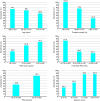How reliable is 12-core prostate biopsy procedure in the detection of prostate cancer?
- PMID: 22398204
- PMCID: PMC3668408
- DOI: 10.5489/cuaj.11224
How reliable is 12-core prostate biopsy procedure in the detection of prostate cancer?
Abstract
Introduction: Prostate biopsies incur the risk of being false-negative and this risk has not yet been evaluated for 12-core prostate biopsy. We calculated the false-negative rate of 12-core prostate biopsy and determined the patient characteristics which might affect detection rate.
Methods: We included 90 prostate cancer patients (mean age of 64, range: 49-77) diagnosed with transrectal ultrasound guided 12-core prostate biopsy between December 2005 and April 2008. All patients underwent radical retropubic prostatectomy and the 12-core prostate biopsy procedure was repeated on surgical specimen ex-vivo. Results of preoperative and postoperative prostate biopsies were compared. We analyzed the influence of patient age, prostate weight, serum prostate-specific antigen (PSA) level, free/total PSA ratio, PSA density and Gleason score on detection rate.
Results: In 67.8% of patients, prostate cancer was detected with repeated ex-vivo biopsies using the same mapping postoperatively. We found an increase in PSA level, PSA density and biopsy Gleason score; patient age, decreases in prostate weight and free/total PSA ratio yielded higher detection rates. All cores, except the left-lateral cores, showed mild-moderate or moderate internal consistency. Preoperative in-vivo biopsy Gleason scores remained the same, decreased and increased in 43.3%, 8.9% and 47.8% of patients, respectively, on final specimen pathology.
Conclusions: The detection rate of prostate cancer with 12-core biopsy in patients (all of whom had prostate cancer) was considerably low. Effectively, repeat biopsies can still be negative despite the patient's reality of having prostate cancer. The detection rate is higher if 12-core biopsies are repeated in younger patients, patients with high PSA levels, PSA density and Gleason scores, in addition in patients with smaller prostates, lower free/total PSA ratios.
Figures
Similar articles
-
Extensive repeat transrectal ultrasound guided prostate biopsy in patients with previous benign sextant biopsies.J Urol. 2000 Jan;163(1):158-62. J Urol. 2000. PMID: 10604336 Clinical Trial.
-
Unilateral positive biopsies in low risk prostate cancer patients diagnosed with extended transrectal ultrasound-guided biopsy schemes do not predict unilateral prostate cancer at radical prostatectomy.BJU Int. 2012 Jul;110(2 Pt 2):E64-8. doi: 10.1111/j.1464-410X.2011.10762.x. Epub 2011 Nov 17. BJU Int. 2012. PMID: 22093108
-
Transperineal prostate biopsy detects significant cancer in patients with elevated prostate-specific antigen (PSA) levels and previous negative transrectal biopsies.BJU Int. 2012 Jul;110(2 Pt 2):E69-75. doi: 10.1111/j.1464-410X.2011.10759.x. Epub 2011 Nov 16. BJU Int. 2012. PMID: 22093091
-
Preoperative prediction of extracapsular tumor extension at radical retropubic prostatectomy in Taiwanese patients with T1c prostate cancer.Jpn J Clin Oncol. 2002 May;32(5):172-6. doi: 10.1093/jjco/hyf036. Jpn J Clin Oncol. 2002. PMID: 12110644
-
Prostate biopsy: who, how and when. An update.Can J Urol. 2005 Feb;12 Suppl 1:44-8; discussion 99-100. Can J Urol. 2005. PMID: 15780165 Review.
Cited by
-
Development and validation of 68Ga-PSMA-11 PET/CT-based radiomics model to detect primary prostate cancer.EJNMMI Res. 2022 Sep 30;12(1):63. doi: 10.1186/s13550-022-00936-5. EJNMMI Res. 2022. PMID: 36175753 Free PMC article.
-
[Multiparametric MRI of the prostate: requirements and principles regarding diagnostic reporting].Urologie. 2023 May;62(5):449-458. doi: 10.1007/s00120-023-02064-x. Epub 2023 Mar 20. Urologie. 2023. PMID: 36941383 Review. German.
-
PSA change after antibiotic treatment should not affect decisionmaking on performing a prostate biopsy.Turk J Med Sci. 2023 Feb;53(1):183-192. doi: 10.55730/1300-0144.5571. Epub 2023 Feb 22. Turk J Med Sci. 2023. PMID: 36945961 Free PMC article.
-
Personalized Risks of Over Diagnosis for Screen Detected Prostate Cancer Incorporating Patient Comorbidities: Estimation and Communication.J Urol. 2019 Nov;202(5):936-943. doi: 10.1097/JU.0000000000000346. Epub 2019 Oct 9. J Urol. 2019. PMID: 31112106 Free PMC article.
-
The current and future role of magnetic resonance imaging in prostate cancer detection and management.Transl Androl Urol. 2015 Jun;4(3):326-41. doi: 10.3978/j.issn.2223-4683.2015.06.05. Transl Androl Urol. 2015. PMID: 26816833 Free PMC article. Review.
References
-
- Hodge KK, McNeal JE, Terris MK, et al. Random systematic versus directed ultrasound guided transrectal core biopsies of the prostate. J Urol. 1989;142:71–4. discussion 74–5. - PubMed
LinkOut - more resources
Full Text Sources
Research Materials
Miscellaneous


